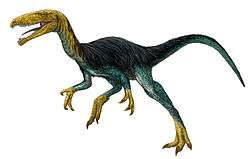Velocisaurus
| Velocisaurus Temporal range: Late Cretaceous, 85 Ma | |
|---|---|
 | |
| Restoration | |
| Scientific classification | |
| Kingdom: | Animalia |
| Phylum: | Chordata |
| Class: | Reptilia |
| Clade: | Dinosauria |
| Order: | Saurischia |
| Suborder: | Theropoda |
| Family: | †Noasauridae |
| Subfamily: | †Noasaurinae |
| Genus: | †Velocisaurus |
| Species: | †V. unicus |
| Binomial name | |
| Velocisaurus unicus Bonaparte, 1991 | |
Velocisaurus ("swift lizard") is a genus of ceratosaurian theropod dinosaur from the Cretaceous period of Argentina.
Description
Velocisaurus was probably around 1.5 meters (4.9 feet) long, based on a tibia length of 14 centimetres (5.5 in).[1] This makes it the smallest noasaurid. The foot is unique in that the middle (third) metatarsal has become the main weight-bearing element. Its upper end has thickened whereas the shafts of the adjoining second and fourth metatarsals have thinned considerably. Such a configuration is unknown for other theropods, including birds. Bonaparte explained it as an adaptation for a cursorial (running) lifestyle. The high speed would have been necessary to escape larger theropods; Bonaparte suggested that Velocisaurus was itself an omnivore, as indicated by the fact that the sole claw found, of the fourth toe, was not trenchant but relatively straight.[2]
History of dicovery
In 1985 Oscar de Ferrariis and Zulma Brandoni de Gasparini uncovered fossils at Boca del Sapo in Neuquén province of Patagonia from layers of the Bajo de la Carpa Formation, dating from the Santonian. Among them was the right lower hind limb of a small theropod. In 1991 this dinosaur was described and named by José Bonaparte as Velocisaurus unicus. The generic name is derived from Latin velox, "swift", a reference to the fact that the hind leg and foot show adaptations for running. The specific name means "unique" in Latin, referring to the exceptional build of the foot. The genus and species are based on the holotype MUCPv 41. It is part of the collection of the Museo de la Universidad Nacional del Comahue.[2] A more complete leg was described in 2016.[3]
Classification
Bonaparte originally assigned Velocisaurus to a family of its own, the Velocisauridae. A study of theropod relationships by Fernando Novas and Sebastian Apesteguia in 2003 showed that Velocisaurus was a close relative of the strange ceratosaur Masiakasaurus. These two may form a subfamily, the Velocisaurinae.[4] In 2004 this subfamily was assigned to the Noasauridae within the more inclusive Abelisauroidea.[5]
Palaeobiology
In a 2001 study conducted by Bruce Rothschild and other paleontologists, 12-foot bones referred to Velocisaurus were examined for signs of stress fracture, but none were found.[6]
See also
Notes
- ↑ Grillo, O. N.; Delcourt, R. (2016). "Allometry and body length of abelisauroid theropods: Pycnonemosaurus nevesi is the new king". Cretaceous Research. doi:10.1016/j.cretres.2016.09.001.
- 1 2 Bonaparte J.F. (1991). "Los vertebrados fósiles de la Formación Rio Colorado, de la Ciudad de Neuquén y Cercanías, Cretácico Superior, Argentina" [The fossil vertebrates of the Rio Colorado Formation, of the city of Neuquén and surroundings, Upper Cretaceous, Argentina]. Revista del Museo Argentino de Ciencias Naturales "Bernardino Rivadavia" e Instituto Nacional de Investigación de las Ciencias Naturales. Paleontología 4: 17-123
- ↑ Egli, F. B.; AgnolÍn, F. L.; Novas, Fernando (2016). "A new specimen of Velocisaurus unicus (Theropoda, Abelisauroidea) from the Paso Córdoba locality (Santonian), Río Negro, Argentina". Journal of Vertebrate Paleontology. 36 (4): e1119156. doi:10.1080/02724634.2016.1119156. ISSN 0272-4634.
- ↑ F. AGNOLÍN, F. NOVAS and S. APESTEGUÍA (2003). "Velocisaurids in South America and Madagascar". Ameghiniana 40(4): 77R. Museo Argentino de Ciencias Naturales ‘B. Rivadavia’, Av. Ángel Gallardo 470, (1405) Buenos Aires, Argentina
- ↑ F. E. Novas, F. L. Agnolin, and S. Bandyopadhyay, 2004, "Cretaceous theropods from India: a review of specimens described by Huene and Matley (1933)", Revista del Museo Argentino de Ciencias Naturales, nuevo serie 6(1): 67-103
- ↑ Rothschild, B., Tanke, D. H., and Ford, T. L., 2001, Theropod stress fractures and tendon avulsions as a clue to activity: In: Mesozoic Vertebrate Life, edited by Tanke, D. H., and Carpenter, K., Indiana University Press, p. 331-336.